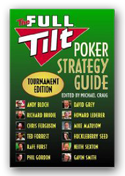 Andy Bloch and Rafe Furst co-authored this chapter of the Full Tilt Poker Strategy Guide: Tournament Edition. It’s a solid if elementary introduction to pot limit for players of no limit hold ’em and outlines the basic differences between the games, though not in great detail.
Andy Bloch and Rafe Furst co-authored this chapter of the Full Tilt Poker Strategy Guide: Tournament Edition. It’s a solid if elementary introduction to pot limit for players of no limit hold ’em and outlines the basic differences between the games, though not in great detail.
They correctly identify the inability to overbet the pot as the central difference between pot limit and no limit hold ’em and go on to enumerate some of the implications of this limitation. Specifically, they address the Gap Concept, the stop-and-go, slowplaying, how short stack play changes, and some unique opportunities for restealing.
Unfortunately, their explanations and advice are overly cursory and sometimes questionable. Their discussion of short stack play, for instance, mentions neither the go-and-go, in which you make a raise or re-raise from out of position with the intention of moving all in on most flops, nor the limp-re-raise, which are both much more important plays as a short stack in pot limit than in no limit hold ’em given the inability to overbet shove pre-flop.
More troublingly, they suggest that with 200-400 blinds, 4000 chips, and a pair of T’s UTG, you might open to 1400 and fold to a reraise. Similarly, they argue that with the same stack “you are in a position to possibly take the pot from the initial raiser without a showdown. If the raiser makes it 1400, you can move in your entire 4000” as a re-steal. Although it’s true that you may sometimes find yourself making more folds and resteals because one raise is less likely to commit a player to the pot, the raiser in both of these examples is getting well over 2:1 on a call and shouldn’t be folding anything.
When discussing starting hand requirements, they suggest playing tighter than in no limit hold ’em for two reasons: the lack of antes and less emphasis on implied odds. This is good advice, but could use some elaboration, particularly the part about implied odds. Although the inability to overbet the pot makes it a bit more difficult to play for stacks, there is still plenty of room to play big pots in pot limit hold ’em, particularly after the first few levels of a tournament.
Moreover, the fact that the pre-flop raiser cannot open for more than three and a half times the big blind makes it a bit easier to take a flop with a speculative hand like a suited connector, especially when you have position. In fact, TJ Cloutier and Tom McEvoy argue in Championship No Limit and Pot Limit Hold ‘Em that small pairs and suited connectors are ideal pot limit hold ’em hands, even more valuable than in no limit hold ’em.
“Pot Limit Hold ‘Em” is the second shortest chapter in the book (after Furst’s solo chapter on Roshambo), and it shows. Although the general strategy that Bloch and Furst outline is on point, a lot of the important details are either missing or misleading.
